Civil engineering
This articleneeds additional citations forverification.(July 2022) |
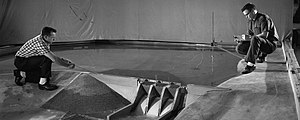
Civil engineeringis aprofessional engineeringdiscipline that deals with thedesign,construction,andmaintenanceof the physical and naturallybuilt environment,includingpublic workssuch as roads, bridges, canals, dams, airports,sewage systems,pipelines,structural componentsof buildings, and railways.[1][2]
Civil engineering is traditionally broken into a number of sub-disciplines. It is considered the second-oldest engineering discipline aftermilitary engineering,[3]and it is defined to distinguish non-military engineering from military engineering.[4]Civil engineering can take place in the public sector from municipalpublic worksdepartments through to federal government agencies, and in the private sector from locally based firms toFortuneGlobal 500companies.[5]
History[edit]
Civil engineering as a discipline[edit]
Civil engineering is the application of physical and scientific principles for solving the problems of society, and its history is intricately linked to advances in the understanding ofphysicsandmathematicsthroughout history. Because civil engineering is a broad profession, including several specialized sub-disciplines, its history is linked to knowledge of structures, materials science, geography,geology,soils,hydrology,environmental science,mechanics,project management,and other fields.[6]
Throughout ancient and medieval history mostarchitectural designand construction was carried out byartisans,such asstonemasonsandcarpenters,rising to the role ofmaster builder.Knowledge was retained inguildsand seldom supplanted by advances. Structures, roads, and infrastructure that existed were repetitive, and increases in scale were incremental.[7]
One of the earliest examples of a scientific approach to physical and mathematical problems applicable to civil engineering is the work ofArchimedesin the 3rd century BC, includingArchimedes' principle,which underpins our understanding ofbuoyancy,and practical solutions such asArchimedes' screw.Brahmagupta,an Indian mathematician, used arithmetic in the 7th century AD, based on Hindu-Arabic numerals, for excavation (volume) computations.[8]
Civil engineering profession[edit]
Engineering has been an aspect of life since the beginnings of human existence. The earliest practice of civil engineering may have commenced between 4000 and 2000 BC inancient Egypt,theIndus Valley civilization,andMesopotamia(ancient Iraq) when humans started to abandon anomadicexistence, creating a need for the construction of shelter. During this time, transportation became increasingly important leading to the development of the wheel andsailing.

Until modern times there was no clear distinction between civil engineering and architecture, and the term engineer and architect were mainly geographical variations referring to the same occupation, and often used interchangeably.[9]The constructions ofpyramidsin Egypt (c. 2700–2500 BC) constitute some of the first instances of large structure constructions in history. Other ancient historic civil engineering constructions include theQanatwater management system in modern-day Iran (the oldest is older than 3000 years and longer than 71 kilometres (44 mi)[10]), theParthenonbyIktinosinAncient Greece(447–438 BC), theAppian WaybyRoman engineers(c. 312 BC), theGreat Wall of Chinaby GeneralMeng T'ienunder orders from Ch'in EmperorShih Huang Ti(c. 220 BC)[11]and the stupas constructed in ancientSri Lankalike theJetavanaramayaand the extensive irrigation works inAnuradhapura.The Romans developed civil structures throughout their empire, including especiallyaqueducts,insulae,harbors, bridges, dams and roads.


In the 18th century, the term civil engineering was coined to incorporate all things civilian as opposed to military engineering.[4]In 1747, the first institution for the teaching of civil engineering, theÉcole Nationale des Ponts et Chaussées,was established in France; and more examples followed in other European countries, likeSpain.[12]The first self-proclaimed civil engineer wasJohn Smeaton,who constructed theEddystone Lighthouse.[3][11]In 1771 Smeaton and some of his colleagues formed the Smeatonian Society of Civil Engineers, a group of leaders of the profession who met informally over dinner. Though there was evidence of some technical meetings, it was little more than a social society.

In 1818 the Institution of Civil Engineers was founded in London,[13]and in 1820 the eminent engineerThomas Telfordbecame its first president. The institution received aRoyal charterin 1828, formally recognising civil engineering as a profession. Its charter defined civil engineering as:
the art of directing the great sources of power in nature for the use and convenience of man, as the means of production and of traffic in states, both for external and internal trade, as applied in the construction of roads, bridges, aqueducts, canals, river navigation and docks for internal intercourse and exchange, and in the construction of ports, harbours, moles, breakwaters and lighthouses, and in the art of navigation by artificial power for the purposes of commerce, and in the construction and application of machinery, and in the drainage of cities and towns.[14]
Civil engineering education[edit]
The first private college to teach civil engineering in the United States wasNorwich University,founded in 1819 by Captain Alden Partridge.[15]The first degree in civil engineering in the United States was awarded byRensselaer Polytechnic Institutein 1835.[16][17]The first such degree to be awarded to a woman was granted byCornell UniversitytoNora Stanton Blatchin 1905.[18]
In the UK during the early 19th century, the division between civil engineering and military engineering (served by theRoyal Military Academy, Woolwich), coupled with the demands of the Industrial Revolution, spawned new engineering education initiatives: the Class of Civil Engineering and Mining was founded atKing's College Londonin 1838, mainly as a response to the growth of the railway system and the need for more qualified engineers, the privateCollege for Civil EngineersinPutneywas established in 1839, and the UK's first Chair of Engineering was established at theUniversity of Glasgowin 1840.
Education[edit]
Civil engineerstypically possess anacademic degreein civil engineering. The length of study is three to five years, and the completed degree is designated as abachelor of technology,or abachelor of engineering.The curriculum generally includes classes in physics, mathematics,project management,design and specific topics in civil engineering. After taking basic courses in most sub-disciplines of civil engineering, they move on to specialize in one or more sub-disciplines at advanced levels. While an undergraduate degree (BEng/BSc) normally provides successful students with industry-accredited qualifications, some academic institutions offer post-graduate degrees (MEng/MSc), which allow students to further specialize in their particular area of interest.[19]
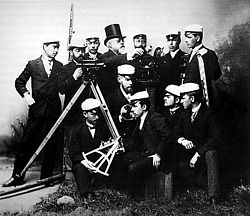
Practicing engineers[edit]
In most countries, a bachelor's degree in engineering represents the first step towardsprofessional certification,and aprofessional bodycertifies the degree program. After completing a certified degree program, the engineer must satisfy a range of requirements including work experience and exam requirements before being certified. Once certified, the engineer is designated as aprofessional engineer(in the United States, Canada and South Africa), achartered engineer(in mostCommonwealthcountries), a chartered professional engineer (in Australia andNew Zealand), or a European engineer (in most countries of theEuropean Union). There are international agreements between relevant professional bodies to allow engineers to practice across national borders.
The benefits of certification vary depending upon location. For example, in the United States and Canada, "only a licensedprofessional engineermay prepare, sign and seal, and submit engineering plans and drawings to a public authority for approval, or seal engineering work for public and private clients. "[20]This requirement is enforced under provincial law such as the Engineers Act inQuebec.[21]No such legislation has been enacted in other countries including the United Kingdom. In Australia, state licensing of engineers is limited to the state ofQueensland.Almost all certifying bodies maintain acode of ethicswhich all members must abide by.[22]
Engineers must obeycontract lawin their contractual relationships with other parties. In cases where an engineer's work fails, they may be subject to the law oftort of negligence,and in extreme cases, criminal charges.[23]An engineer's work must also comply with numerous other rules and regulations such asbuilding codesandenvironmental law.
Sub-disciplines[edit]

There are a number of sub-disciplines within the broad field of civil engineering. General civil engineers work closely with surveyors and specialized civil engineers to design grading, drainage,pavement,water supply, sewer service, dams, electric and communications supply. General civil engineering is also referred to as site engineering, a branch of civil engineering that primarily focuses on converting a tract of land from one usage to another. Site engineers spend time visiting project sites, meeting with stakeholders, and preparing construction plans. Civil engineers apply the principles of geotechnical engineering, structural engineering, environmental engineering, transportation engineering and construction engineering to residential, commercial, industrial and public works projects of all sizes and levels of construction.
Coastal engineering[edit]

Coastal engineeringis concerned with managing coastal areas. In some jurisdictions, the terms sea defense and coastal protection mean defense against flooding and erosion, respectively. Coastal defense is the more traditional term, but coastal management has become popular as well.
Construction engineering[edit]
Construction engineeringinvolves planning and execution, transportation of materials, site development based on hydraulic, environmental, structural and geotechnical engineering. As construction firms tend to have higher business risk than other types of civil engineering firms do, construction engineers often engage in more business-like transactions, for example, drafting and reviewing contracts, evaluatinglogistical operations,and monitoring prices of supplies.
Earthquake engineering[edit]
Earthquake engineeringinvolves designing structures to withstand hazardous earthquake exposures. Earthquake engineering is a sub-discipline of structural engineering. The main objectives of earthquake engineering are[24]to understand interaction of structures on the shaky ground; foresee the consequences of possible earthquakes; and design, construct and maintain structures toperformat earthquake in compliance withbuilding codes.
Environmental engineering[edit]

Environmental engineeringis the contemporary term forsanitary engineering,though sanitary engineering traditionally had not included much of the hazardous waste management and environmental remediation work covered by environmental engineering. Public health engineering and environmental health engineering are other terms being used.
Environmental engineering deals with treatment of chemical, biological, or thermal wastes, purification of water and air, andremediationof contaminated sites after waste disposal or accidental contamination. Among the topics covered by environmental engineering are pollutant transport,water purification,waste water treatment,air pollution,solid waste treatment,recycling,andhazardous waste management.Environmental engineers administer pollution reduction,green engineering,andindustrial ecology.Environmental engineers also compile information on environmental consequences of proposed actions.
Forensic engineering[edit]
Forensic engineeringis the investigation of materials,products,structures or components that fail or do not operate or function as intended, causing personal injury or damage to property. The consequences of failure are dealt with by the law of product liability. The field also deals with retracing processes and procedures leading to accidents in operation of vehicles or machinery. The subject is applied most commonly in civil law cases, although it may be of use in criminal law cases. Generally the purpose of a Forensic engineering investigation is to locate cause or causes of failure with a view to improve performance or life of a component, or to assist a court in determining the facts of an accident. It can also involve investigation of intellectual property claims, especiallypatents.
Geotechnical engineering[edit]

Geotechnical engineeringstudies rock and soil supporting civil engineering systems. Knowledge from the field ofsoil science,materials science,mechanics,andhydraulicsis applied to safely and economically designfoundations,retaining walls,and other structures. Environmental efforts to protectgroundwaterand safely maintain landfills have spawned a new area of research called geo-environmental engineering.[25][26]
Identification of soil properties presents challenges to geotechnical engineers.Boundary conditionsare often well defined in other branches of civil engineering, but unlike steel or concrete, the material properties and behavior of soil are difficult to predict due to its variability and limitation oninvestigation.Furthermore, soil exhibits nonlinear (stress-dependent)strength,stiffness, and dilatancy (volume change associated with application ofshear stress), making studyingsoil mechanicsall the more difficult.[25]Geotechnical engineers frequently work with professionalgeologists,Geological Engineeringprofessionals and soil scientists.[27]
Materials science and engineering[edit]
Materials scienceis closely related to civil engineering. It studies fundamental characteristics of materials, and deals with ceramics such as concrete and mix asphalt concrete, strong metals such as aluminum and steel, andthermosetting polymersincludingpolymethylmethacrylate(PMMA) and carbon fibers.
Materials engineeringinvolves protection and prevention (paints and finishes). Alloying combines two types of metals to produce another metal with desired properties. It incorporates elements ofapplied physicsandchemistry.With recent media attention onnanoscienceandnanotechnology,materials engineering has been at the forefront of academic research. It is also an important part of forensic engineering andfailure analysis.
Site development and planning[edit]

Site development,also known assite planning,is focused on the planning and development potential of a site as well as addressing possible impacts frompermittingissues andenvironmental challenges.[28]
Structural engineering[edit]
Structural engineeringis concerned with thestructural designandstructural analysisof buildings, bridges,towers,flyovers(overpasses), tunnels, off shore structures like oil and gas fields in the sea,aerostructureand other structures. This involves identifying the loads which act upon a structure and the forces and stresses which arise within that structure due to those loads, and then designing the structure to successfully support and resist those loads. The loads can be self weight of the structures, other dead load, live loads, moving (wheel) load, wind load, earthquake load, load from temperature change etc. The structural engineer must design structures to be safe for their users and to successfully fulfill the function they are designed for (to beserviceable). Due to the nature of some loading conditions, sub-disciplines within structural engineering have emerged, includingwind engineeringand earthquake engineering.[29]
Design considerations will include strength, stiffness, and stability of the structure when subjected to loads which may be static, such as furniture or self-weight, or dynamic, such as wind, seismic, crowd or vehicle loads, or transitory, such as temporary construction loads or impact. Other considerations include cost, constructibility, safety, aesthetics andsustainability.
Surveying[edit]
Surveyingis the process by which a surveyor measures certain dimensions that occur on or near the surface of the Earth. Surveying equipment such as levels and theodolites are used for accurate measurement of angular deviation, horizontal, vertical and slope distances. With computerisation, electronic distance measurement (EDM), total stations, GPS surveying and laser scanning have to a large extent supplanted traditional instruments. Data collected by survey measurement is converted into a graphical representation of the Earth's surface in the form of a map. This information is then used by civil engineers, contractors and realtors to design from, build on, and trade, respectively. Elements of a structure must be sized and positioned in relation to each other and to site boundaries and adjacent structures.
Although surveying is a distinct profession with separate qualifications and licensing arrangements, civil engineers are trained in the basics of surveying and mapping, as well asgeographic information systems.Surveyors also lay out the routes of railways,tramway tracks,highways, roads, pipelines and streets as well as position other infrastructure, such asharbors,before construction.
- Land surveying
In the United States, Canada, the United Kingdom and most Commonwealth countries land surveying is considered to be a separate and distinct profession.Land surveyorsare not considered to be engineers, and have their own professional associations and licensing requirements. The services of a licensed land surveyor are generally required for boundary surveys (to establish the boundaries of a parcel using its legal description) and subdivision plans (a plot or map based on a survey of a parcel of land, with boundary lines drawn inside the larger parcel to indicate the creation of new boundary lines and roads), both of which are generally referred to asCadastral surveying.
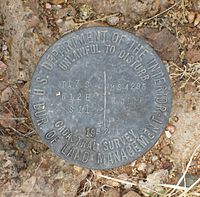
- Construction surveying
Construction surveying is generally performed by specialized technicians. Unlike land surveyors, the resulting plan does not have legal status. Construction surveyors perform the following tasks:
- Surveying existing conditions of the future work site, including topography, existing buildings and infrastructure, and underground infrastructure when possible;
- "lay-out" or "setting-out": placing reference points and markers that will guide the construction of new structures such as roads or buildings;
- Verifying the location of structures during construction;
- As-Built surveying: a survey conducted at the end of the construction project to verify that the work authorized was completed to the specifications set on plans.
Transportation engineering[edit]
Transportation engineeringis concerned with moving people and goods efficiently, safely, and in a manner conducive to a vibrant community. This involves specifying, designing, constructing, and maintaining transportation infrastructure which includes streets, canals, highways,rail systems,airports, ports, andmass transit.It includes areas such as transportation design,transportation planning,traffic engineering,some aspects ofurban engineering,queueing theory,pavement engineering,Intelligent Transportation System(ITS), and infrastructure management.
Municipal or urban engineering[edit]

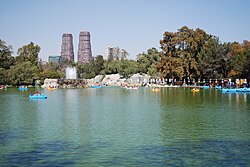
Municipal engineeringis concerned with municipal infrastructure. This involves specifying, designing, constructing, and maintaining streets,sidewalks,water supply networks,sewers,street lighting,municipal solid wastemanagement and disposal, storage depots for various bulk materials used for maintenance and public works (salt, sand, etc.),public parksandcycling infrastructure.In the case of undergroundutilitynetworks, it may also include the civil portion (conduits and access chambers) of the local distribution networks of electrical and telecommunications services. It can also include the optimization of waste collection andbus servicenetworks. Some of these disciplines overlap with other civil engineering specialties, however municipal engineering focuses on the coordination of these infrastructure networks and services, as they are often built simultaneously, and managed by the same municipal authority. Municipal engineers may also design the site civil works for large buildings, industrial plants or campuses (i.e. access roads, parking lots, potable water supply, treatment or pretreatment of waste water, site drainage, etc.)
Water resources engineering[edit]
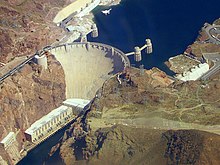
Water resources engineeringis concerned with the collection and management of water (as anatural resource). As a discipline it therefore combines elements of hydrology, environmental science,meteorology,conservation,andresource management.This area of civil engineering relates to the prediction and management of both the quality and the quantity of water in both underground (aquifers) and above ground (lakes, rivers, and streams) resources. Water resource engineers analyze and model very small to very large areas of the earth to predict the amount and content of water as it flows into, through, or out of a facility. Although the actual design of the facility may be left to other engineers.
Hydraulic engineeringis concerned with the flow and conveyance of fluids, principally water. This area of civil engineering is intimately related to the design ofpipelines,water supply network,drainage facilities (including bridges, dams,channels,culverts,levees,storm sewers), and canals. Hydraulic engineers design these facilities using the concepts offluid pressure,fluid statics,fluid dynamics,and hydraulics, among others.
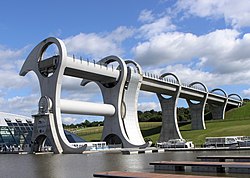
Civil engineering systems[edit]
Civil engineering systems is a discipline that promotes the use ofsystems thinkingto manage complexity and change in civil engineering within its wider public context. It posits that the proper development of civil engineeringinfrastructurerequires aholistic,coherent understanding of the relationships between all of the important factors that contribute to successful projects while at the same time emphasizing the importance of attention to technical detail. Its purpose is to help integrate the entire civil engineeringproject life cyclefrom conception, through planning, designing, making, operating to decommissioning.[30][31]
See also[edit]
- Architectural engineering
- Civil engineering software
- Engineering drawing
- Geological Engineering
- Geomatics engineering
- Glossary of civil engineering
- Index of civil engineering articles
- List of civil engineers
- List of engineering branches
- List of Historic Civil Engineering Landmarks
- Macro-engineering
- Railway engineering
- Site survey
Associations[edit]
- American Society of Civil Engineers
- Canadian Society for Civil Engineering
- Chartered Institution of Civil Engineering Surveyors
- Council for the Regulation of Engineering in Nigeria
- Earthquake Engineering Research Institute
- Engineers Australia
- European Federation of National Engineering Associations
- International Federation of Consulting Engineers
- Indian Geotechnical Society
- Institution of Civil Engineers
- Institution of Structural Engineers
- Institute of Engineering(Nepal)
- International Society of Soil Mechanics and Geotechnical Engineering
- Institution of Engineers, Bangladesh
- Institution of Engineers (India)
- Institution of Engineers of Ireland
- Institute of Transportation Engineers
- Japan Society of Civil Engineers
- Pakistan Engineering Council
- Philippine Institute of Civil Engineers
- Transportation Research Board
References[edit]
- ^"History and Heritage of Civil Engineering".American Society of Civil Engineers.Archived fromthe originalon 16 February 2007.Retrieved8 August2007.
- ^"What is Civil Engineering".Institution of Civil Engineers.14 January 2022.Retrieved15 May2017.
- ^ab"What is Civil Engineering?".Canadian Society for Civil Engineering.Archived fromthe originalon 12 August 2007.Retrieved8 August2007.
- ^ab"Civil engineering".Encyclopædia Britannica.Retrieved9 August2007.
- ^"Working in the Public Sector Versus Private Sector for Civil Engineering Professionals".The Civil Engineering Podcast.Engineering Management Institute. 5 June 2019.
- ^Baveystock, Nick (8 August 2013)."So what does a civil engineer do, exactly?".The Guardian.Retrieved11 September2020.
- ^Saouma, Victor E."Lecture Notes in Structural Engineering"(PDF).University of Colorado. Archived fromthe original(PDF)on 19 April 2011.Retrieved2 November2007.
- ^Colebrook, Henry Thomas (1817).Algebra: with Arithmetic and mensuration.London.
- ^Murray, Peter (1986).The Architecture of the Italian Renaissance.Knopf Doubleday.ISBN0-8052-1082-2.[page needed]
- ^Mays, L. (2010).Ancient Water Technologies.Springer. p. 4.ISBN978-90-481-8631-0.
- ^abOakes, William C.; Leone, Les L.; Gunn, Craig J. (2001).Engineering Your Future.Great Lakes Press.ISBN978-1-881018-57-5.
- ^Dirección General de Obras Públicas Spain (1856).Memoria sobre el estado de las obras públicas en España en 1856 presentada al excmo. sr. Ministro de Fomento por la Dirección General de Obras Públicas.Madrid: National Press.
- ^"Our history".Institution of Civil Engineers. 2 December 2015.Retrieved12 April2018.
- ^"Institution of Civil Engineers' website".Retrieved26 December2007.
- ^"Norwich University Legacy Website".Archived fromthe originalon 6 July 2014.Retrieved15 December2008.
- ^Griggs, Francis E Jr. "Amos Eaton was Right!".Journal of Professional Issues in Engineering Education and Practice,Vol. 123, No. 1, January 1997, pp. 30–34.
- ^"RPI Timeline".Archived fromthe originalon 2 July 2014.Retrieved14 September2007.
- ^"Nora Stanton Blatch Barney".Encyclopædia BritannicaOnline.Retrieved8 October2010.
- ^,"Cite Postgrad".Archived fromthe originalon 6 November 2008.
- ^"Why Should You Get Licensed?".National Society of Professional Engineers.Archived fromthe originalon 4 June 2005.Retrieved11 August2007.
- ^"Engineers Act".Quebec Statutes and Regulations (CanLII).Archived fromthe originalon 5 October 2006.Retrieved11 August2007.
- ^"Ethics Codes and Guidelines".Online Ethics Center.Archived fromthe originalon 2 February 2016.Retrieved11 August2007.
- ^"Singapore's Circle Line criminal trial started".New Civil Engineer.Retrieved16 November2013.
- ^Chen, W-F; Scawthorn, C. (2003), "Chapter 2",Earthquake Engineering Handbook,CRC Press,ISBN0-8493-0068-1
- ^abMitchell, James Kenneth (1993).Fundamentals of Soil Behavior(2nd ed.). John Wiley and Sons. pp. 1–2.
- ^Shroff, Arvind V.; Shah, Dhananjay L. (2003).Soil Mechanics and Geotechnical Engineering.Taylor & Francis. pp. 1–2.
- ^"Geotechnical/Geological Engineering"(PDF).Professional Careers in the Mineral Industry.The Australasian Institute of Mining and Metallurgy.Archived(PDF)from the original on 20 July 2008.Retrieved30 May2018.
- ^"Site Development and Planning".Nobis Group.Retrieved7 September2020.
- ^Narayanan, R; Beeby, A (2003).Introduction to Design for Civil Engineers.London: Spon.
- ^Labi, Samuel (2014).Introduction to Civil Engineering Systems: A Systems Perspective to the Development of Civil Engineering Facilities.John Wiley.ISBN978-0-470-53063-4.
- ^Blockley, David; Godfrey, Patrick (2017).Doing it Differently: Systems for Rethinking Infrastructure(2nd ed.). London: ICE Publications.ISBN978-0-7277-6082-1.
Further reading[edit]
- Blockley, David (2014).Structural Engineering: a very short introduction.New York: Oxford University Press.ISBN978-0-19-967193-9.
- Chen, W.F.; Liew, J.Y. Richard, eds. (2002).The Civil Engineering Handbook.CRC Press.ISBN978-0-8493-0958-8.
- Muir Wood, David (2012).Civil Engineering: a very short introduction.New York:Oxford University Press.ISBN978-0-19-957863-4.
- Ricketts, Jonathan T.; Loftin, M. Kent; Merritt, Frederick S., eds. (2004).Standard handbook for civil engineers(5 ed.). McGraw Hill.ISBN978-0-07-136473-7.

